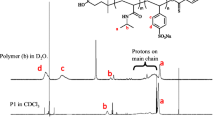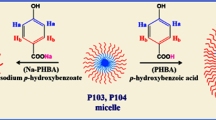Abstract
The micelle formation of a poly(4-pyridinemethoxymethylstyrene)-block-polystyrene diblock copolymer (PPySt-b-PSt) was investigated in nonselective solvents using bifunctional and trifunctional carboxylic acids. The copolymer showed no self-assembly in 1,4-dioxane and tetrahydrofuran (THF) because the PPySt and PSt blocks were solvophilic to the solvents. Dynamic light scattering studies demonstrated that the copolymer formed micelles in the nonselective solvents in the presence of bifunctional carboxylic acids. Oxalic acid, maleic acid, citric acid, and phospholic acid promoted the micellization, while malonic acid, succinic acid, and glutalic acid had no effect on the micellization. The micellar size, aggregation number, and critical micelle concentration were dependent not only on the acid strength but also on the type of acid and the functionality. The micellization was also affected by the solvent quality. The micellization proceeded more effectively in 1,4-dioxane than in THF. It was found that the micellization occurred by hydrogen bonding between the pyridine moiety and the carboxylic acid and by the interaction among the carboxylic acids. This is because the copolymer needed over an equivalent of the acid to the PySt unit to complete the micellization. Furthermore, monofunctional carboxylic acid such as trichloroacetic acid and trifluoroacetic acid promoted the micellization, although dichloroacetic acid had no effect on the micellization.












Similar content being viewed by others
References
Schwarz V (1962) Collect Czechoslov Chem Commun 27:2567
Hakimelahi GH, Proba ZA, Ogilvie KK (1981) Tetrahedron Lett 22:4775
Woodward RB, Heusler K, Gosteli J, Naegeli P, Oppolzer W, Ramage R, Ranganathan S, Vorbuggen H (1966) J Am Chem Soc 88:852
Martin TJ, Prochazka K, Munk P, Webber SE (1996) Macromolecules 29:6071
Gohy JF, Lohmeijer BGG, Varshney SK, Decamps B, Leroy E, Boileau S, Schubert US (2002) Macromolecules 35:9748
Wangqing Z, Shi L, An Y, Wu K, Gao L, Liu Z, Ma R, Meng Q, Zhao C, He B (2004) Macromolecules 37:2924
Zhang W, Shi L, Gao L, An Y, Li G, Wu K, Liu Z (2005) Macromolecules 38:899
Gohy JF, Varshney SK, Jerome R (2001) Macromolecules 34:3361
Yao X, Chen D, Jiang M (2004) J Phys Chem B 108:5225
Liu S, Zhang G, Jiang M (1999) Polymer 40:5449
Duan H, Chen D, Jiang M, Gan W, Li S, Wang M, Gong J (2001) J Am Chem Soc 123:12097
Yoshida E, Tanaka M, Takata T (2005) Colloid Polym Sci 283:1100
Yoshida E, Tanaka M, Takata T (2005) Colloid Polym Sci 284:51
Morrison ID, Grabowski EF, Herb CA (1985) Langmuir 1:496
Lide DR (ed) (1995) CRC handbook of chemistry and physics, 76th edn. CRC, Boca Raton
March J (1985) Advanced organic chemistry, 3rd edn. Wiley, New York
Boutonnet JC, Bingham P, Calamari D, De Rooij C, Franklin J, Kawano T, Libre JM, McCulloch A, Malinverno G, Odom JM, Rusch GM, Smythe K, Sobolev I, Thompson R, Tiedje JM (1999) Hum Ecol Risk Assess 5:59
Author information
Authors and Affiliations
Corresponding author
Rights and permissions
About this article
Cite this article
Yoshida, E., Ohta, M. Micelle formation of a diblock copolymer having pyridine as pendant groups by carboxylic acids in nonselective solvents. Colloid Polym Sci 284, 718–724 (2006). https://doi.org/10.1007/s00396-005-1411-5
Received:
Accepted:
Published:
Issue Date:
DOI: https://doi.org/10.1007/s00396-005-1411-5




